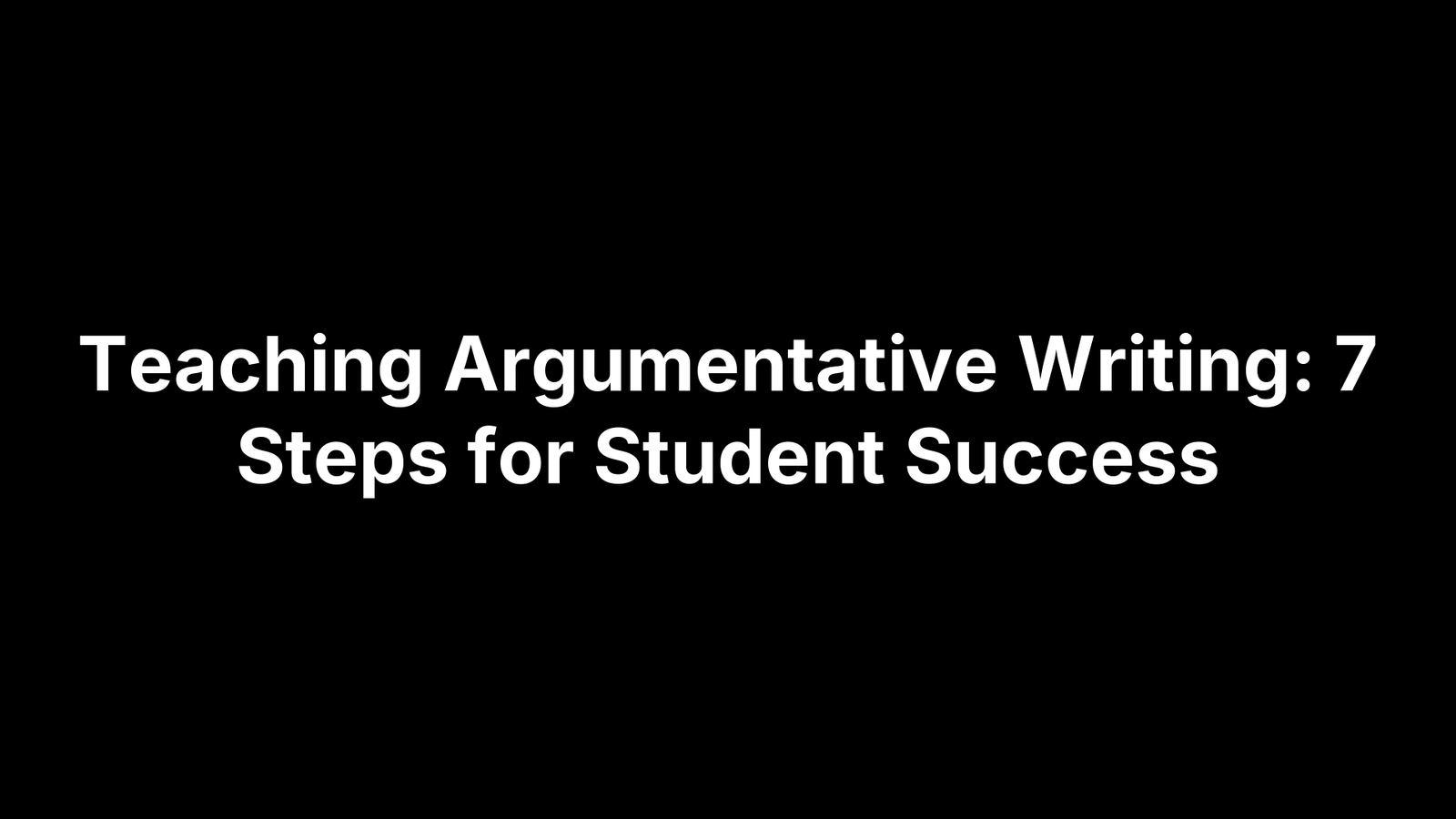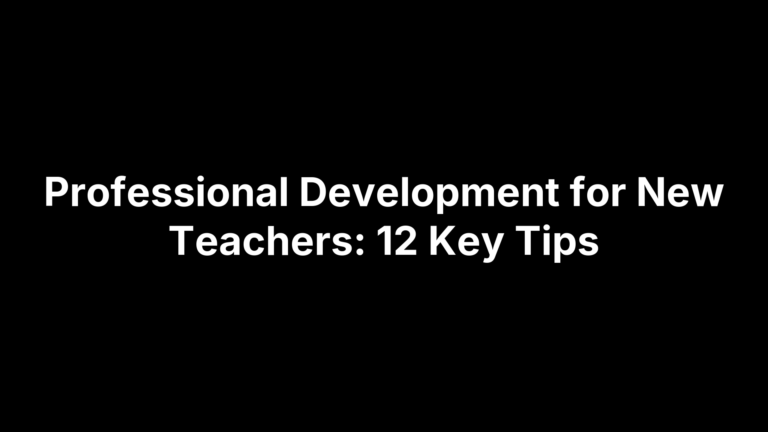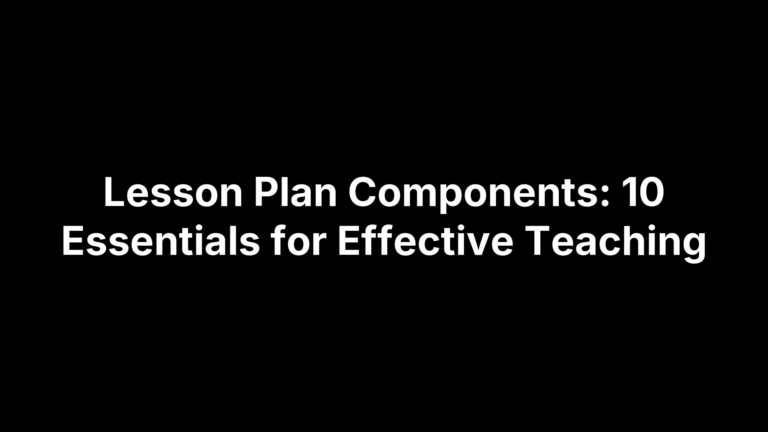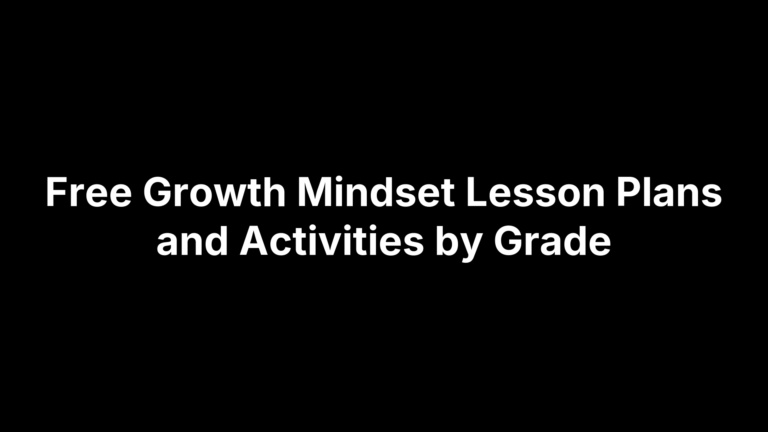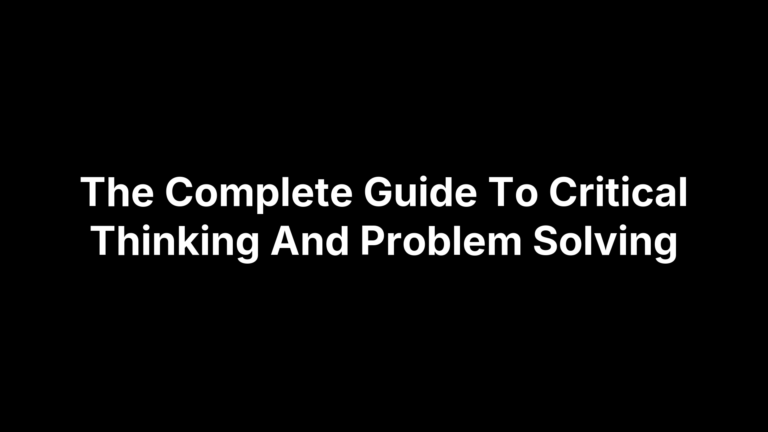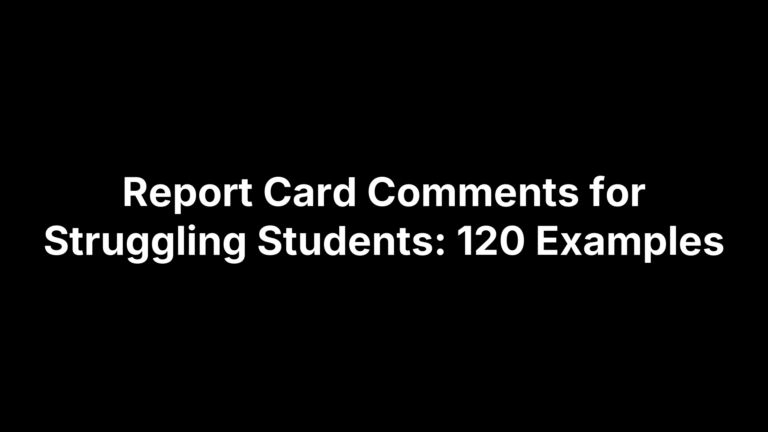How to Teach Argumentative Writing: A Step-By-Step Framework
You’ve explained claim and evidence a dozen times, yet many students still hand in five-paragraphs of opinion wrapped in filler. This guide fixes that. Drawing on classroom-tested routines, it walks you through a seven-step framework that takes writers from initial spark to published piece, with mini-lessons, graphic organizers, and debate activities ready for Monday morning. Whether you teach fifth grade or AP Lang, the process aligns with CCSS W.1, TEKS 6.11, and adapts easily to block or 45-minute periods.
Inside, you’ll find answers to every “How do I…” query dominating Google results—hooking reluctant writers, teaching counterclaims without chaos, grading efficiently, and more. Each step tackles a common pain point, offers concrete student samples, and integrates AI tools to save prep time. By the end, your class will craft arguments that stand up to real scrutiny and real audiences.
Let’s dive into the first step—hooking students with arguments that matter to them.
Step 1: Hook Students with Real-World Arguments They Care About
Before students can master teaching argumentative writing, they need a reason to argue beyond “because the rubric says so.” Engagement is the fast pass to rigor; when the topic hits close to home, even the quietest students suddenly have receipts and opinions. Start the unit, then, by lighting a fire under issues they encounter every day.
Connect to Students’ Interests and Daily Life
Give students a minute to vent productively. Post a quickwrite prompt:
“What rule, trend, or situation at school really grinds your gears—and why?”
After three minutes, invite a few volunteers to share. You’ll generate an instant list of authentic controversies:
- Cell-phone bans during lunch
- Mandatory camera-on policies for remote learners
- Dress-code wording that seems unfair
- Whether varsity athletes should get exam exemptions
- Cafeteria meatless Mondays
Transfer the brainstorm to an anchor chart titled “Arguments Worth Having.” Keep it visible all unit long so students can revisit or add new ideas.
For fresh reading material, pull age-appropriate articles from Newsela, Scholastic Kids Press, Teen Ink, or the local newspaper’s youth section. A headline about streaming service password sharing often sparks more debate than national politics, and it models how writers ground arguments in specific contexts.
Analyze High-Interest Mentor Texts Together
Now that curiosity is piqued, show students how published writers build persuasion. Select a one-page editorial or even a spicy social-media exchange (bleep expletives as needed). Read it aloud, then project the text and color-code:
- Claim (blue)
- Evidence (green)
- Tone and audience cues (yellow)
Ask guiding questions:
- “What sentence tells you the author’s main point?”
- “Which piece of evidence made you nod—or roll your eyes?”
- “How is the tone helping or hurting their credibility?”
Students copy the color-coding into notebooks, creating a running library of mentor moves they can steal later.
Run a Low-Stakes Classroom Debate as Pre-Writing
Finally, let them test-drive their positions verbally before drafting.
- Set up a 4-Corners debate: label classroom corners Strongly Agree, Agree, Disagree, Strongly Disagree. Read a provocative statement (“Teachers should grade homework for neatness”) and have students stand in the corner that matches their stance.
- Give 30 seconds for partner talk using sentence stems like “I understand your point; however,…” or “Building on what you said,…”.
- Rotate two spokespeople from each corner into a Fishbowl circle for a short, moderated discussion while the rest take notes on compelling reasoning.
Debrief in writing: “Which argument changed your mind or strengthened your own? Why?” This reflection converts lively discussion into concrete evidence of persuasive techniques, priming students for Step 2’s deep dive into structure.
By anchoring the unit in personal relevance, you ensure that every subsequent mini-lesson lands on fertile ground—attention, motivation, and a healthy dose of spirited disagreement.
Step 2: Deconstruct the Architecture of an Argument
Students now care about the issue; the next hurdle is seeing how effective arguments are built. Many essays crumble because writers pile facts without realizing how each piece should fit together. By demystifying structure, you give them a mental blueprint they can apply every time they sit down to write. This step turns “I have opinions” into “I can prove it.”
Introduce the Core Components: Claim, Reason, Evidence, Counterclaim, Rebuttal
Kick off with a quick poll—“What are the five key factors of an argumentative essay?”—and watch guesses fly. Then reveal a one-page infographic or slide that lists the non-negotiables. A concise chart keeps the terminology straight:
| Component | Guiding Question | Student Example (School Dress Code) |
|---|---|---|
| Claim | What is your stance? | “The dress code unfairly targets girls.” |
| Reason | Why do you hold that stance? | “Because the wording singles out leggings.” |
| Evidence | How can you prove it? | “School discipline records show 85% of violations are issued to female students.” |
| Counterclaim | What might someone argue against you? | “Dress codes promote professionalism.” |
| Rebuttal | How will you address that pushback? | “Professionalism can be taught without gendered restrictions.” |
Tips for clarity:
- Keep each reason distinct; if two reasons overlap, merge or rewrite.
- Evidence must be verifiable—statistics, expert quotes, or documented anecdotes.
- A rebuttal is not a roast; tone remains respectful and fact-based.
Make students co-create additional examples on a Jamboard to cement understanding. This interactive naming process is pure gold for teaching argumentative writing because it forces precise language.
Visual Mapping with Graphic Organizers
Once the parts are clear, show how they snap together. Model a Claim-Evidence-Reasoning (CER) organizer under a document camera:
- Write the claim in the top box.
- List three evidence snippets in the left column.
- Connect each piece of evidence to a specific reason on the right.
Thinking aloud, narrate choices: “Notice I dropped survey data here because it directly backs my second reason about student opinion.” Students copy the partially filled organizer, then finish it in pairs—low cognitive load, high payoff.
Alternative formats:
- T-Chart for pro/con brainstorming before picking a side.
- Color-coded sticky notes on a whiteboard for kinesthetic learners.
- Digital mind-mapping tools (e.g., Google Drawings) for Chromebook classrooms.
The visual step prevents the classic problem of writers stacking three unrelated quotes in one paragraph.
Compare Argument Formats Students May Encounter
Academic writing isn’t one-size-fits-all. Give learners a cheat sheet comparing three common frameworks they’ll bump into from middle school through college:
| Format | Signature Moves | Best For | Quick Tip |
|---|---|---|---|
| Classical (Aristotelian) | Intro → Thesis → Proof → Refutation → Conclusion | Timed essays, standardized tests | Keep paragraphs tight—one reason per body paragraph. |
| Toulmin | Claim → Data → Warrant → Backing → Qualifier → Rebuttal | Research papers, policy proposals | The “warrant” explains why the data matters; don’t skip it. |
| Rogerian | Opposing view → Common ground → Your position | Highly polarizing topics | Open with empathy to lower reader resistance. |
Discuss when to pick each. For example, a school policy letter may thrive on the Classical model’s directness, while a community op-ed about climate action could benefit from Rogerian diplomacy.
To drive the point home, have teams recast their dress-code argument in two formats and share which felt more natural. This meta-comparison sharpens rhetorical awareness and prepares students for varied writing demands.
By the end of Step 2, the fog has lifted: students possess a shared vocabulary, a visual toolkit, and flexible templates. They’re now equipped to research with purpose—exactly where Step 3 picks up.
Step 3: Teach Credible Research and Evidence-Gathering Skills
Now that students can visualize an argument’s framework, they have to fill it with facts rather than hot air. Solid research separates persuasive writing from a cafeteria rant; it is the backbone that lets claims withstand cross-examination from peers, parents, and standardized-test scorers alike. Yet many young writers Google once, click the first link, and call it a day. This step makes credibility explicit, routinizes note-taking, and keeps plagiarism nightmares at bay.
Evaluating Sources for Credibility and Bias
Kick off with a two-minute think-pair-share: “How do you know whether something online is trustworthy?” Expect answers like “It looks professional,” which sets the stage for deeper vetting using the CRAAP or SIFT methods.
- CRAAP Test
- Currency – When was it published or updated?
- Relevance – Does it answer our research question?
- Authority – Who wrote it, and what makes them an expert?
- Accuracy – Can the claims be verified elsewhere?
- Purpose – Is the goal to inform, sell, entertain, or persuade?
Alternative: SIFT (Stop, Investigate the source, Find corroboration, Trace claims).
Model the process live: project two articles on “school cell-phone bans,” one from a peer-reviewed journal and one from a click-bait blog. Walk through each CRAAP criterion, giving it a score of 1-5. Students record scores on a simple checklist and decide which article deserves a spot in their essay binder.
Quick extension: introduce free fact-checking tools like Google’s “About this result” panel or Wikipedia’s reference section, reminding learners that Wikipedia is a launch pad, not a terminal citation.
Note-Taking Strategies: Quote, Paraphrase, Summarize
Even credible sources are useless if students can’t retrieve information efficiently. Teach a three-column Cornell note sheet labeled Quote | Paraphrase | Why It Matters. Demonstrate with a passage:
“Eighty-five percent of dress-code violations were issued to female students in 2023.”
- Quote: copy verbatim with quotation marks.
- Paraphrase: “Most infractions went to girls last year.”
- Why It Matters: “Supports claim that the rule targets females.”
Color-code evidence types to speed later drafting:
- Statistics = blue
- Expert testimony = green
- Anecdotes = yellow
Digital classrooms can replicate this with Google Keep or Notion cards tagged by color. For students who need extra scaffolding, offer fill-in-the-blank sentence starters:
- Statistic: “According to ___, ___% of ___…”
- Expert: “Dr. ___ argues that ___…”
- Anecdote: “In one student’s experience, ___…”
Finish the mini-lesson with a “30-minute evidence dash.” In pairs, students hunt for three different evidence types supporting any claim from the Step 1 debate list and store them in their notes.
Avoiding Plagiarism and Citing Sources
Teaching argumentative writing also means teaching academic integrity. Display two sample paragraphs: one lifted word-for-word, the other properly cited. Ask, “Which writer keeps their scholarship and which gets Saturday school?” Discuss consequences—zeros, parent calls, potential legal issues in college.
Break down the basics:
- Use quotation marks for exact words.
- Paraphrases must change structure and vocabulary.
- Always include an in-text citation.
Provide the MLA formula in code tags so students can paste it without formatting errors:(Author's Last Name page#)
No page number? Use the first word of the Works Cited entry:(Smith)
“Citation Station” activity (10 minutes):
- Post three source snippets around the room or in breakout rooms.
- Students rotate, write a one-sentence paraphrase, and add the correct MLA parenthetical.
- Quick whole-class check—project answers and have students self-score.
Wrap up by reminding writers that accurate citations boost ethos; they show readers the argument is built on verifiable ground, not wishful thinking. When students head into Step 4, they’ll wield a curated bank of credible, well-labeled evidence ready to power a laser-focused thesis.
Step 4: Craft Powerful Claims and a Clear Thesis Statement
Research notes in hand, students often try to dump everything they found onto the page. The cure is focus—distilling all that information into one arguable sentence that guides the entire essay. In teaching argumentative writing, this is the moment where a loud brainstorm turns into a laser-sharp thesis. The following mini-lessons move writers from a sprawling topic to a defensible claim supported by reasons they can actually prove.
From Broad Topic to Narrow Claim
Start by sketching an “umbrella” on the board—each rib represents a layer of specificity:
School → School Rules → Dress Code → Gender Bias in Dress Code → “The current dress code unfairly targets female students and should be revised.”
Walk through two more examples as a class, then have pairs complete the progression for their own topics. Tips that keep claims tight:
- State one clear position—avoid “and/or” mash-ups.
- Use assertive verbs: should ban, must allow, is ineffective.
- Make the claim debatable; if everyone already agrees, it’s not an argument.
Checkpoint: ask students to underline the verb and circle the issue in their sentence. If either is missing, the claim is still too broad.
Align Reasons With Available Evidence
A strong thesis is only as sturdy as the reasons propping it up. Introduce the quick “Because Test”:
- Write the claim.
- Add the word because and finish the sentence three different ways using evidence already collected.
Example:
“The dress code is inequitable because 85 % of citations go to girls, because its language singles out female-coded clothing, because national studies link strict dress codes to lower self-esteem.”
If a “because” feels forced or repeats an earlier idea, it’s a red flag to refine either the evidence or the reason. Post a mini-checklist students can keep in their notebooks:
- Each reason is distinct (no duplicates).
- Evidence exists in notes for every reason.
- Reasons directly support—not merely relate to—the claim.
The Thesis Workshop: Real-Time Feedback
Turn your room into a thesis lab for one class period:
- Station Rotation – Desks labeled Green (Go), Yellow (Clarify), Red (Rethink). Writers place their thesis at a station and rotate, leaving color-coded sticky feedback.
- Digital Jamboard – For 1:1 classrooms, create three frames mirroring the colors; peers drag virtual sticky notes under each thesis.
Model feedback language first:
- Green: “Precise and debatable—ready for body paragraphs.”
- Yellow: “Verb is clear, but define too much screen time.”
- Red: “Tackles two issues; split into separate claims.”
Close with a rapid revision cycle. Display two examples on the projector:
Weak: “School rules can be unfair sometimes.”
Revised: “Middle schools should allow monitored phone use during lunch because it fosters social connection, teaches digital responsibility, and reduces covert texting in class.”
Ask students to spotlight the improvements—specific issue, assertive verb, preview of reasons. Writers then polish their own sentences and paste the finished thesis at the top of their outline, ready for Step 5’s paragraph scaffolds.
By the end of this workshop, every student holds a claim that is narrow, arguable, and backed by evidence—exactly the anchor they need to draft with confidence.
Step 5: Scaffold the Drafting Process for Cohesive Arguments
Even with a laser-sharp thesis and folders of evidence, many adolescents freeze at a blinking cursor. Scaffolding turns that paralysis into purposeful prose by giving students bite-size writing tasks, visual cues, and concrete language they can plug in immediately. When teaching argumentative writing, think of yourself as setting up climbing holds on a rock wall—each framework, transition list, and style checklist is another place for writers to grab on and keep moving upward.
Paragraph Frameworks: PEEL/TEEL and CER
Start by handing students a paragraph “skeleton” so they know exactly where each idea belongs. Two classroom favorites:
| Framework | What the Letters Mean | When to Use It |
|---|---|---|
| PEEL/TEEL | Point (or Topic sentence) – Evidence – Explanation – Link | Standard body paragraphs; great for timed writing where concision counts |
| CER | Claim – Evidence – Reasoning | Science or data-heavy arguments that need explicit warranting |
Model the build in real time. Project a blank PEEL organizer and narrate:
- Point: “Leggings bans disproportionately punish female students.”
- Evidence: “According to 2023 referral logs, 85 % of dress-code citations went to girls.”
- Explanation: “The statistic shows the policy isn’t applied evenly, undermining its fairness.”
- Link: “Therefore, the dress code requires revision to ensure gender equity.”
For writers who need more support, offer fill-in-the-blank starters:
- Point: One clear example of ___ is ___.
- Evidence: Data from ___ shows that “___.”
- Explanation: This proves ___ because ___.
- Link: Consequently, ___.
Collect finished paragraphs and give rapid feedback on whether each sentence matches its slot. The physical structure makes logical flow visible and prevents quote dumps.
Using Transitions for Logical Flow
Once sentences exist, transitions stitch them into a seamless argument. Share an anchor chart (or digital slide) grouping words by purpose:
| Addition | Contrast | Cause/Effect | Emphasis |
|---|---|---|---|
| furthermore | however | therefore | indeed |
| also | on the other hand | as a result | in fact |
| moreover | yet | because of this | notably |
Two-Sentence Remix Activity:
- Distribute slips with pairs of short, choppy sentences.
- “Dress codes claim to promote professionalism. Violations target mostly girls.”
- Students choose a transition from the chart and rewrite the pair into one cohesive sentence.
- Volunteers share; classmates identify the transition’s function.
This micro-practice shows that word choice guides readers through reasoning, not just decorates prose.
Apply the Six C’s for Style and Clarity
A paragraph can be structurally sound yet still read like a legal disclaimer. Enter the Six C’s—traits professional writers habitually check:
- Clarity – Is the main idea unmistakable?
- Conciseness – Can extra words go?
- Coherence – Do ideas stick together logically?
- Correctness – Are grammar and citations accurate?
- Courtesy – Is the tone respectful, especially in rebuttals?
- Conviction – Does the voice sound confident and purposeful?
Provide a one-page self-editing checklist:
- Highlight any sentence longer than 25 words; split or trim if needed.
- Circle pronouns—draw an arrow to their clear antecedent.
- Underline verbs; swap weak forms (is, are, was) for stronger action verbs.
- Verify every quote has an MLA citation.
- Star places where tone could be misread; soften with courteous language.
Give students five minutes to run the checklist on one body paragraph, then swap with a partner for a second pass. Because the criteria are concrete, feedback focuses on craft instead of vague “sounds weird” comments.
With frameworks securing structure, transitions ensuring flow, and the Six C’s sharpening style, students leave Step 5 not just with paragraphs on the page but with paragraphs that work. Next, they’ll stress-test those arguments by inviting opposing views in Step 6.
Step 6: Strengthen Arguments with Counterclaims and Rebuttals
Your students now have coherent body paragraphs, but real-world readers don’t nod politely—they push back. Teaching argumentative writing isn’t complete until writers can anticipate objections, address them with facts, and avoid cheap shots that undercut credibility. This step trains students to invite dissent, answer it professionally, and leave the audience thinking, “Well, that’s hard to argue with.”
Identifying Potential Counterclaims
Start by reframing disagreement as an asset, not a threat. Display a blank T-chart labeled Claim and What Someone Might Say, then model with a neutral topic like school uniforms. Ask guiding questions:
- Who benefits from the current policy?
- What evidence could opponents bring up?
- Which values—cost, safety, tradition—might drive their stance?
Students brainstorm three counterclaims for their own essay on sticky notes and sort them by strength:
- 🔴 Strong (supported by data)
- 🟡 Moderate (anecdotal)
- 🟢 Weak (based on assumptions)
This visual ranking helps writers pick at least one substantial counterclaim worth addressing. For reluctant classes, hand out “Devil’s Advocate Cards” with generic counterarguments they can adapt:
- “It’s too expensive…”
- “It disrupts learning…”
- “There isn’t enough evidence…”
Collect cards after use so students move beyond stock phrases in later drafts.
Writing Respectful, Evidence-Backed Rebuttals
Once a counterclaim is nailed down, the goal is to acknowledge it, then turn the argumentative judo flip—using evidence to show why your original claim still stands. Provide a three-step formula:
- Acknowledge: “Some may argue that …”
- Response: “However, recent data from …”
- Reinforce Claim: “Therefore, the policy should still be revised.”
Comparison table of tone:
| Weak Approach | Why It Fails | Strong Approach | Why It Works |
|---|---|---|---|
| “That idea is ridiculous.” | Dismissive, alienates reader | “While some believe camera-on policies boost engagement, district attendance reports show no significant change.” | Respects opponent, cites evidence |
Quick-fire practice: students rewrite three overheated rebuttals into courteous, fact-based versions using sentence frames such as “Even though ___, the evidence indicates ___.” Peer partners check for courtesy and citation.
Deepening Reasoning and Avoiding Logical Fallacies
Good rebuttals can still collapse if they lean on faulty logic. Present a mini-slide deck of the Big Four classroom fallacies:
- Straw Man: Misrepresenting the opponent. “Opponents hate all school rules.”
- Slippery Slope: Predicting doom. “If phones are allowed at lunch, grades will plummet.”
- Ad Hominem: Attacking the person. “Only lazy students want easier dress codes.”
- Bandwagon: “Everyone else already does this.”
Keep it light with memes or teacher-approved GIFs to anchor each concept. Then distribute a peer-editing checklist:
- Did I summarize the opposing view accurately?
- Is my rebuttal supported by at least one credible source?
- Have I avoided the Big Four fallacies?
- Does my tone stay academic and courteous?
Partners apply the list to one another’s work, highlighting any logical gaps. If a fallacy pops up, the reviewer labels it in the margin with a brief fix suggestion, e.g., “Clarify causal link—avoid slippery slope.”
Conclude the lesson by asking students to underline their counterclaim paragraph and annotate the margin with the source that best supports their rebuttal. This self-audit nudges writers to verify they’ve met both structural and ethical standards.
By welcoming counterarguments and knocking them down with solid evidence—minus the snark—students elevate their essays from persuasive monologues to balanced, intellectually honest conversations. With the heavy lifting done, Step 7 will polish these arguments for audiences beyond your classroom walls.
Step 7: Revise, Edit, and Publish for Authentic Audiences
Drafting may feel like crossing the finish line, but experienced writers know the real magic happens in revision. At this stage of teaching argumentative writing, we flip the classroom from composer to editor and from student to author with readers. Sharpening ideas, tightening prose, and packaging the final product for real eyes transforms “just another essay” into persuasive communication that matters beyond a gradebook.
Peer Review Protocols That Actually Work
Unfocused peer review often devolves into “looks good” scribbles. Replace vague feedback with purpose-built routines:
Glow & Grow
- Students highlight one glow (something effective) in green and one grow (area to strengthen) in yellow.
- Prompts: “Glow: Your rebuttal cites district data.” / “Grow: Consider adding a transition between paragraphs three and four.”
Two Stars and a Wish
- Writers receive two compliments (stars) and one actionable suggestion (wish).
- Sentence frames keep comments specific:
- Star: “Your evidence is recent and credible.”
- Wish: “Explain why the expert’s credentials matter to the argument.”
Colored Comment Layers
Color Focus Example Comment Blue Ideas & Evidence “Add one more statistic to support Reason #2.” Orange Organization “Move this counterclaim earlier for better flow.” Purple Style & Mechanics “Watch subject-verb agreement in this sentence.”
Rotate roles so every writer receives varied perspectives. Timebox: 10 minutes silent read, 10 minutes comment, 5 minutes debrief. Students leave with actionable next steps rather than cryptic margin notes.
Use Rubrics and Checklists for Self-Assessment
Peer feedback is powerful, but internal reflection cements learning. Provide a student-friendly rubric mirrored on the seven steps:
| Criterion | Exceeds | Meets | Approaching |
|---|---|---|---|
| Engagement (Hook) | Topic is original & personally relevant | Topic is relevant | Topic feels assigned |
| Architecture | All five elements—claim, reasons, evidence, counterclaim, rebuttal—present & balanced | One element weak or missing | Multiple elements missing |
| Credible Evidence | Variety of vetted sources, MLA perfect | Sources credible, minor citation errors | Few sources or major citation gaps |
| Cohesion & Style (6 C’s) | Consistently clear, concise, coherent, correct, courteous, conviction | Minor lapses | Frequent lapses |
| Revision Effort | Major structural improvements | Minor sentence-level edits | Little evidence of change |
Alongside the rubric, supply a one-page Revision Checklist:
- ☐ Hook and thesis align
- ☐ Each paragraph follows PEEL/CER framework
- ☐ Transitions guide reader logically
- ☐ Counterclaim paragraph includes respectful rebuttal
- ☐ No highlighted fallacies
- ☐ MLA Works Cited complete
Students highlight rubric boxes that match evidence in their draft, then draft a 3-sentence revision plan (“I will reorder paragraphs two and three to improve cause-effect flow…”). This metacognitive pause prevents random tinkering and promotes targeted upgrades.
Publish and Reflect
Writing for an audience beyond the teacher cranks up authenticity—and effort. Offer tiered options so every student can share comfortably:
- Class Blog or Google Site – Embed essays; enable moderated comments for peer discussion.
- Op-Ed Submission – Print or email top pieces to the school or local newspaper. Template letters minimize logistical hurdles.
- Letters to Stakeholders – Send dress-code arguments to the principal, or phone-policy proposals to the PTA.
- Podcast or Video Roundtable – Students record 3-minute audio summaries; free tools like Vocaroo make production painless.
After publication, guide reflection with prompts:
- “Which revision made the biggest impact on your persuasiveness?”
- “How did writing for a real audience change your word choice or tone?”
- “Where else might you use counterclaim-rebuttal skills?”
Collect responses as Flipgrid videos or exit tickets to surface transferable insights.
Authentic sharing closes the loop: students see their words prompt reactions—agreement, pushback, genuine curiosity. That ripple effect is the ultimate proof that argumentative writing isn’t just an academic exercise; it’s a life skill with real-world reach.
Keep the Argument Going
Great argumentative essays don’t happen by accident—they follow a repeatable rhythm. In this guide you learned how teaching argumentative writing can flow from curiosity to publication in seven purposeful moves:
- Hook students with issues they actually debate
- Reveal the blueprint: claim, reason, evidence, counterclaim, rebuttal
- Gather rock-solid research and cite it ethically
- Distill findings into a focused, provable thesis
- Draft with PEEL/CER paragraphs, smart transitions, and the Six C’s
- Invite opposing views, then rebut them respectfully and logically
- Revise, edit, and publish for an audience that exists beyond your gradebook
Put just one or two of these steps into tomorrow’s lesson and you’ll notice tighter logic and louder student voices. When you’re ready for printable organizers or AI-powered planning tools, swing by The Cautiously Optimistic Teacher and grab the free resources waiting for you. Your students’ next argument starts there.
